Nghiên cứu về giao tiếp liên văn hóa: Việc đáp lại lời than phiền giữa người Việt Nam và người Anh
Trên nền tảng lý thuyết của hành động lời nói, lời than phiền là một phần tất yếu trong cuộc sống
hàng ngày của chúng ta và trong môi trường đa văn hóa hiện nay. Quan trọng hơn là chúng ta
cần trau dồi cho những người giao tiếp từ những nền văn hóa khác nhau với những kiến thức
cần thiết về việc giải quyết như thế nào với lời than phiền. Nghiên cứu này nhằm mục đích điều
tra các chiến lược ưa thích mà người Anh và người Việt Nam sử dụng để đáp lại lời than phiền.
Hơn thế nữa, bài viết còn nhằm tìm hiểu sự khác biệt khi người giao tiếp sử dụng những chiến
lược trong những tình huống khác nhau và những người đối thoại khác nhau. Với mục đích điều
tra kỹ lưỡng các chiến lược đáp lại lời than phiền, phương pháp định tính và định lượng được áp
dụng trong quá trình phân tích dữ liệu. Kết quả cho thấy, có 13 chiến lược ưa thích được sử dụng
khi người Việt Nam và người Anh đáp lại lời than phiền và thực sự có nhiều sự khác nhau trong
việc lựa chọn chiến lược của họ. Có thể kết luận rằng, một số lưu ý về văn hoá đã được gợi ý cho
những người đang sinh sống, học tập và làm việc trong môi trường đa văn hóa bao gồm cả Anh
và Việt Nam.
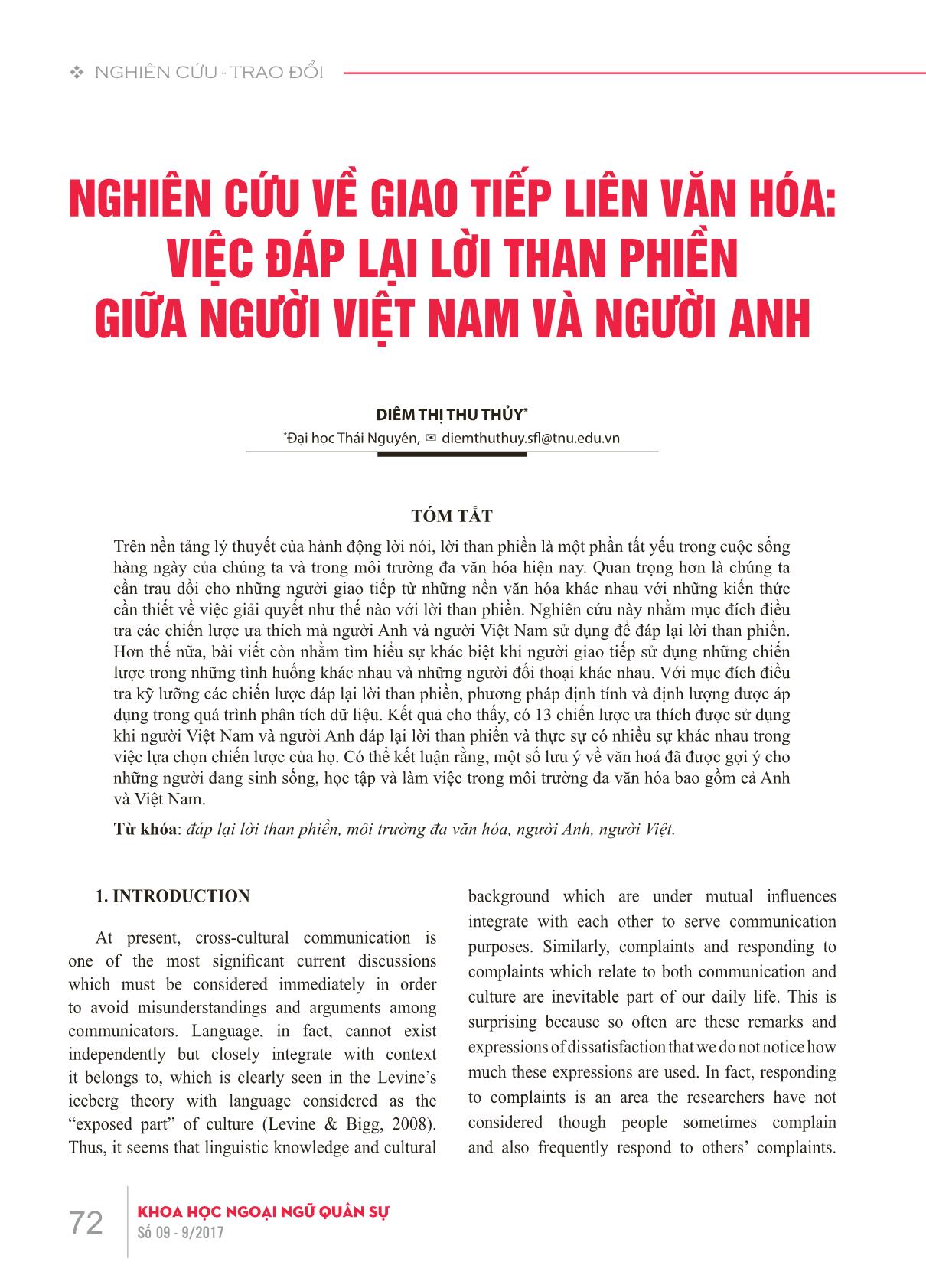
Trang 1
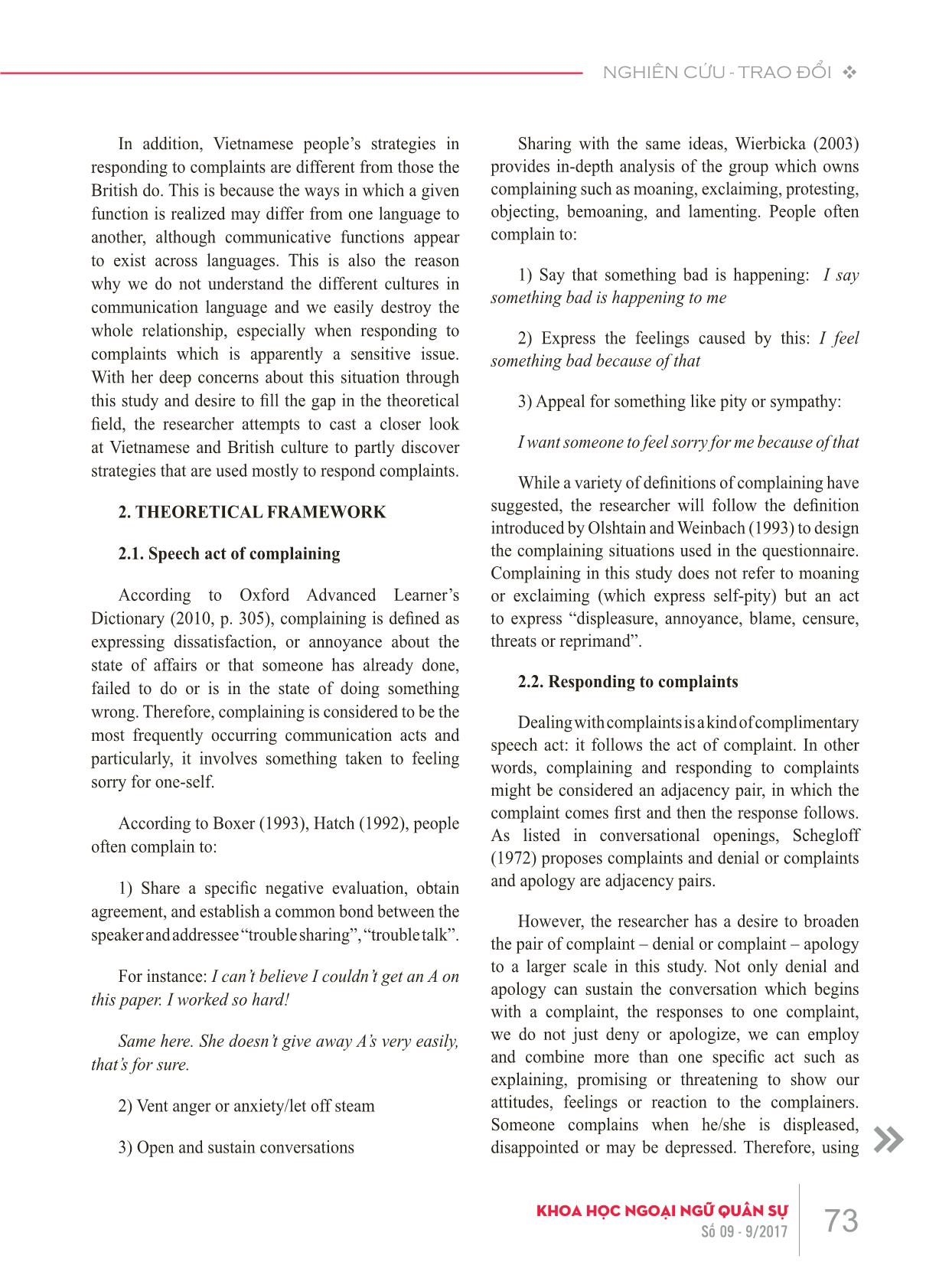
Trang 2
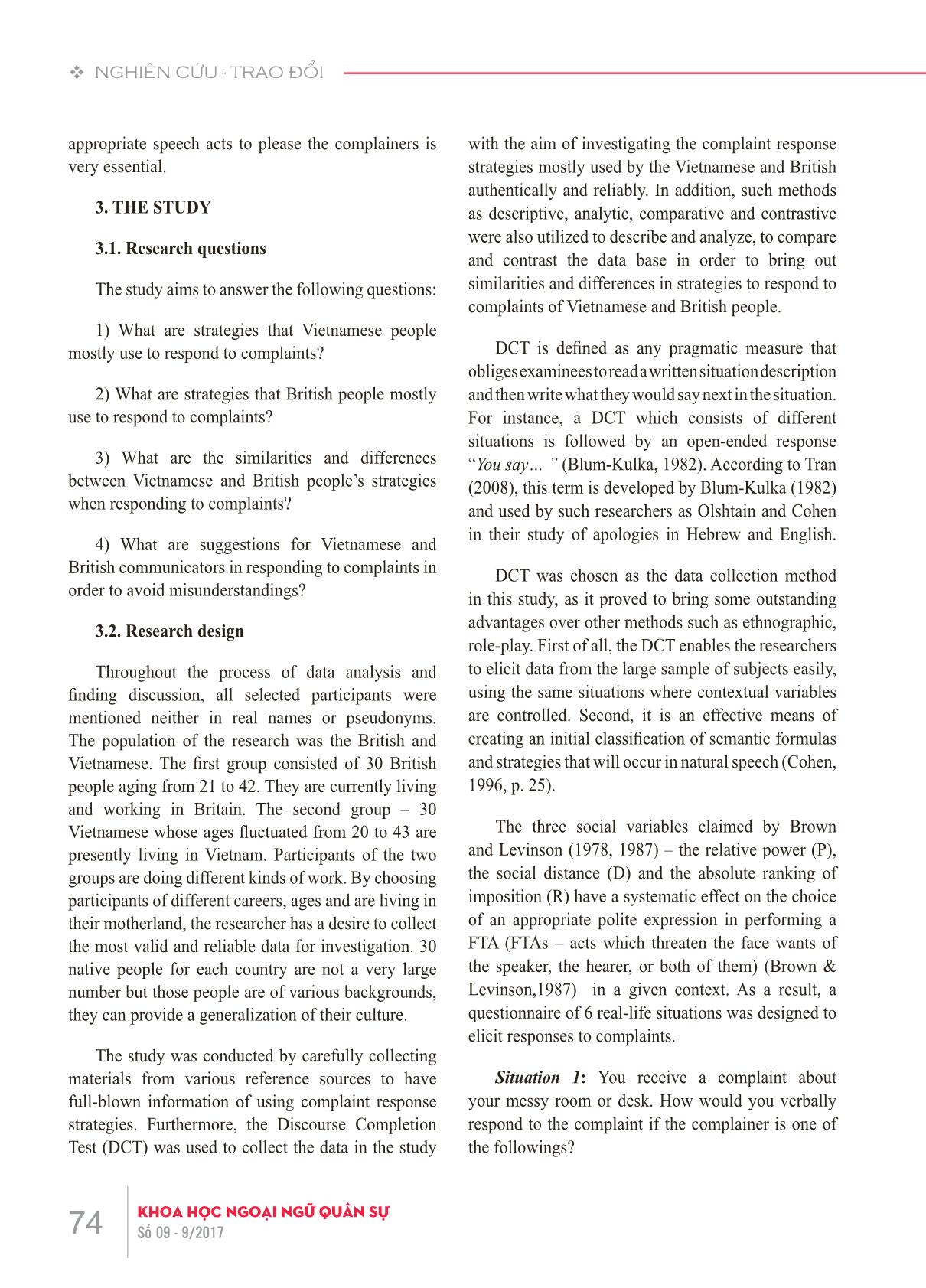
Trang 3
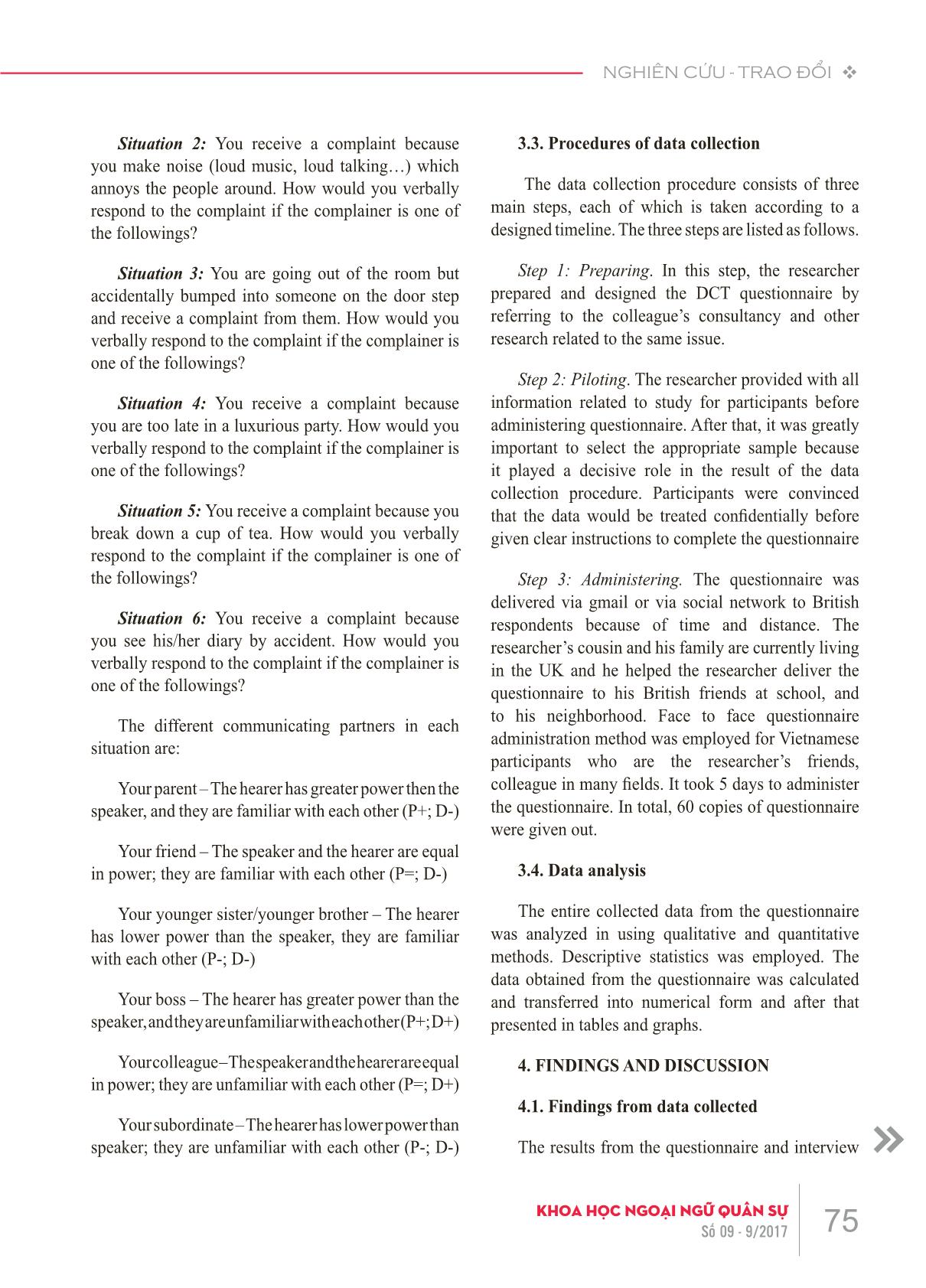
Trang 4
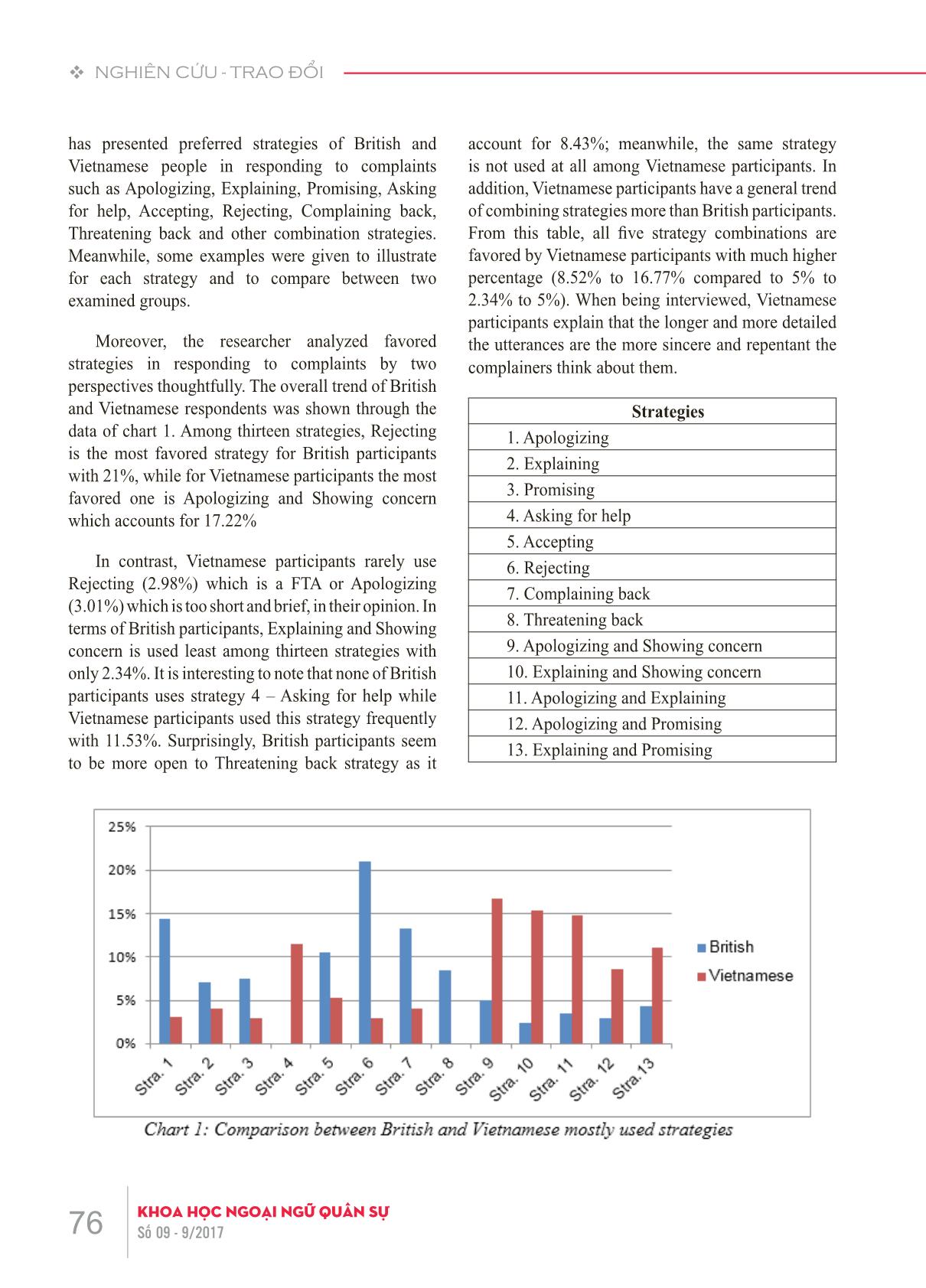
Trang 5
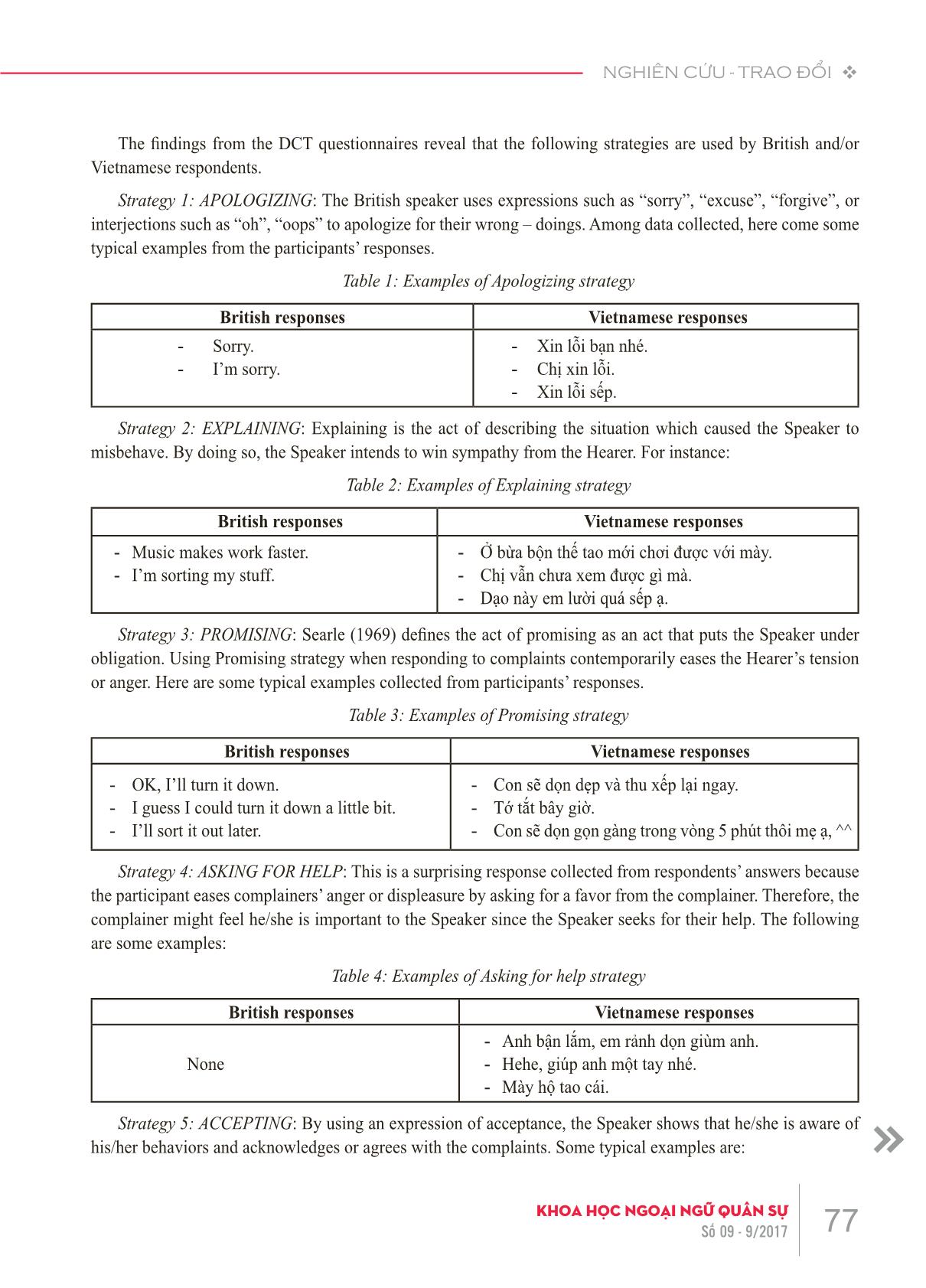
Trang 6
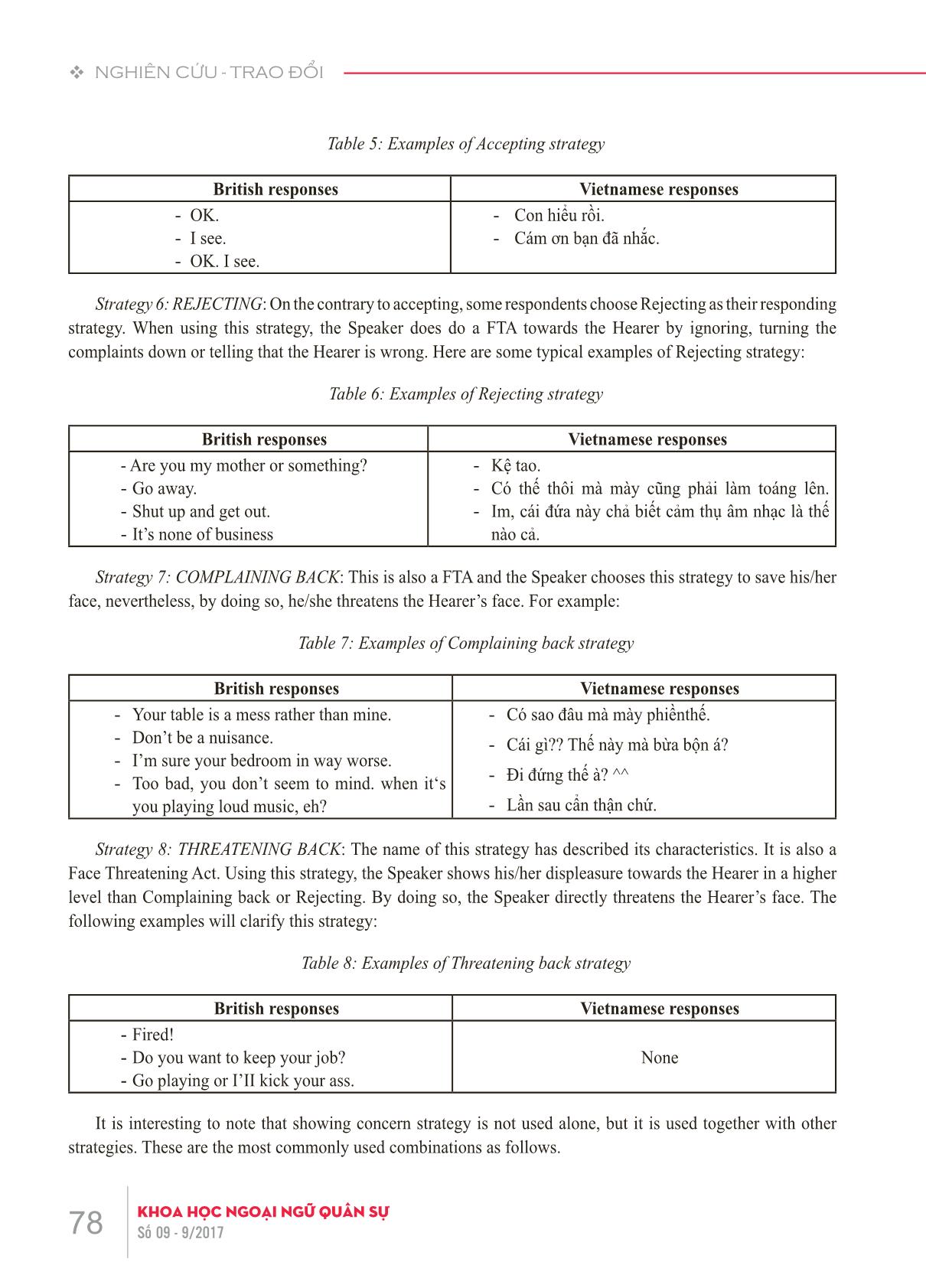
Trang 7
Tóm tắt nội dung tài liệu: Nghiên cứu về giao tiếp liên văn hóa: Việc đáp lại lời than phiền giữa người Việt Nam và người Anh
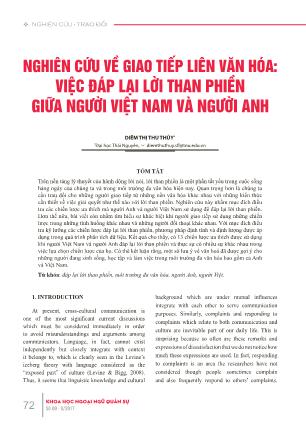
the researcher has a desire to broaden the pair of complaint – denial or complaint – apology to a larger scale in this study. Not only denial and apology can sustain the conversation which begins with a complaint, the responses to one complaint, we do not just deny or apologize, we can employ and combine more than one specific act such as explaining, promising or threatening to show our attitudes, feelings or reaction to the complainers. Someone complains when he/she is displeased, disappointed or may be depressed. Therefore, using 74 KHOA HỌC NGOẠI NGỮ QUÂN SỰSố 09 - 9/2017 v NGHIÊN CỨU - TRAO ĐỔI appropriate speech acts to please the complainers is very essential. 3. THE STUDY 3.1. Research questions The study aims to answer the following questions: 1) What are strategies that Vietnamese people mostly use to respond to complaints? 2) What are strategies that British people mostly use to respond to complaints? 3) What are the similarities and differences between Vietnamese and British people’s strategies when responding to complaints? 4) What are suggestions for Vietnamese and British communicators in responding to complaints in order to avoid misunderstandings? 3.2. Research design Throughout the process of data analysis and finding discussion, all selected participants were mentioned neither in real names or pseudonyms. The population of the research was the British and Vietnamese. The first group consisted of 30 British people aging from 21 to 42. They are currently living and working in Britain. The second group – 30 Vietnamese whose ages fluctuated from 20 to 43 are presently living in Vietnam. Participants of the two groups are doing different kinds of work. By choosing participants of different careers, ages and are living in their motherland, the researcher has a desire to collect the most valid and reliable data for investigation. 30 native people for each country are not a very large number but those people are of various backgrounds, they can provide a generalization of their culture. The study was conducted by carefully collecting materials from various reference sources to have full-blown information of using complaint response strategies. Furthermore, the Discourse Completion Test (DCT) was used to collect the data in the study with the aim of investigating the complaint response strategies mostly used by the Vietnamese and British authentically and reliably. In addition, such methods as descriptive, analytic, comparative and contrastive were also utilized to describe and analyze, to compare and contrast the data base in order to bring out similarities and differences in strategies to respond to complaints of Vietnamese and British people. DCT is defined as any pragmatic measure that obliges examinees to read a written situation description and then write what they would say next in the situation. For instance, a DCT which consists of different situations is followed by an open-ended response “You say ” (Blum-Kulka, 1982). According to Tran (2008), this term is developed by Blum-Kulka (1982) and used by such researchers as Olshtain and Cohen in their study of apologies in Hebrew and English. DCT was chosen as the data collection method in this study, as it proved to bring some outstanding advantages over other methods such as ethnographic, role-play. First of all, the DCT enables the researchers to elicit data from the large sample of subjects easily, using the same situations where contextual variables are controlled. Second, it is an effective means of creating an initial classification of semantic formulas and strategies that will occur in natural speech (Cohen, 1996, p. 25). The three social variables claimed by Brown and Levinson (1978, 1987) – the relative power (P), the social distance (D) and the absolute ranking of imposition (R) have a systematic effect on the choice of an appropriate polite expression in performing a FTA (FTAs – acts which threaten the face wants of the speaker, the hearer, or both of them) (Brown & Levinson,1987) in a given context. As a result, a questionnaire of 6 real-life situations was designed to elicit responses to complaints. Situation 1: You receive a complaint about your messy room or desk. How would you verbally respond to the complaint if the complainer is one of the followings? 75KHOA HỌC NGOẠI NGỮ QUÂN SỰSố 09 - 9/2017 NGHIÊN CỨU - TRAO ĐỔI v Situation 2: You receive a complaint because you make noise (loud music, loud talking) which annoys the people around. How would you verbally respond to the complaint if the complainer is one of the followings? Situation 3: You are going out of the room but accidentally bumped into someone on the door step and receive a complaint from them. How would you verbally respond to the complaint if the complainer is one of the followings? Situation 4: You receive a complaint because you are too late in a luxurious party. How would you verbally respond to the complaint if the complainer is one of the followings? Situation 5: You receive a complaint because you break down a cup of tea. How would you verbally respond to the complaint if the complainer is one of the followings? Situation 6: You receive a complaint because you see his/her diary by accident. How would you verbally respond to the complaint if the complainer is one of the followings? The different communicating partners in each situation are: Your parent – The hearer has greater power then the speaker, and they are familiar with each other (P+; D-) Your friend – The speaker and the hearer are equal in power; they are familiar with each other (P=; D-) Your younger sister/younger brother – The hearer has lower power than the speaker, they are familiar with each other (P-; D-) Your boss – The hearer has greater power than the speaker, and they are unfamiliar with each other (P+; D+) Your colleague – The speaker and the hearer are equal in power; they are unfamiliar with each other (P=; D+) Your subordinate – The hearer has lower power than speaker; they are unfamiliar with each other (P-; D-) 3.3. Procedures of data collection The data collection procedure consists of three main steps, each of which is taken according to a designed timeline. The three steps are listed as follows. Step 1: Preparing. In this step, the researcher prepared and designed the DCT questionnaire by referring to the colleague’s consultancy and other research related to the same issue. Step 2: Piloting. The researcher provided with all information related to study for participants before administering questionnaire. After that, it was greatly important to select the appropriate sample because it played a decisive role in the result of the data collection procedure. Participants were convinced that the data would be treated confidentially before given clear instructions to complete the questionnaire Step 3: Administering. The questionnaire was delivered via gmail or via social network to British respondents because of time and distance. The researcher’s cousin and his family are currently living in the UK and he helped the researcher deliver the questionnaire to his British friends at school, and to his neighborhood. Face to face questionnaire administration method was employed for Vietnamese participants who are the researcher’s friends, colleague in many fields. It took 5 days to administer the questionnaire. In total, 60 copies of questionnaire were given out. 3.4. Data analysis The entire collected data from the questionnaire was analyzed in using qualitative and quantitative methods. Descriptive statistics was employed. The data obtained from the questionnaire was calculated and transferred into numerical form and after that presented in tables and graphs. 4. FINDINGS AND DISCUSSION 4.1. Findings from data collected The results from the questionnaire and interview 76 KHOA HỌC NGOẠI NGỮ QUÂN SỰSố 09 - 9/2017 v NGHIÊN CỨU - TRAO ĐỔI has presented preferred strategies of British and Vietnamese people in responding to complaints such as Apologizing, Explaining, Promising, Asking for help, Accepting, Rejecting, Complaining back, Threatening back and other combination strategies. Meanwhile, some examples were given to illustrate for each strategy and to compare between two examined groups. Moreover, the researcher analyzed favored strategies in responding to complaints by two perspectives thoughtfully. The overall trend of British and Vietnamese respondents was shown through the data of chart 1. Among thirteen strategies, Rejecting is the most favored strategy for British participants with 21%, while for Vietnamese participants the most favored one is Apologizing and Showing concern which accounts for 17.22% In contrast, Vietnamese participants rarely use Rejecting (2.98%) which is a FTA or Apologizing (3.01%) which is too short and brief, in their opinion. In terms of British participants, Explaining and Showing concern is used least among thirteen strategies with only 2.34%. It is interesting to note that none of British participants uses strategy 4 – Asking for help while Vietnamese participants used this strategy frequently with 11.53%. Surprisingly, British participants seem to be more open to Threatening back strategy as it account for 8.43%; meanwhile, the same strategy is not used at all among Vietnamese participants. In addition, Vietnamese participants have a general trend of combining strategies more than British participants. From this table, all five strategy combinations are favored by Vietnamese participants with much higher percentage (8.52% to 16.77% compared to 5% to 2.34% to 5%). When being interviewed, Vietnamese participants explain that the longer and more detailed the utterances are the more sincere and repentant the complainers think about them. Strategies 1. Apologizing 2. Explaining 3. Promising 4. Asking for help 5. Accepting 6. Rejecting 7. Complaining back 8. Threatening back 9. Apologizing and Showing concern 10. Explaining and Showing concern 11. Apologizing and Explaining 12. Apologizing and Promising 13. Explaining and Promising 77KHOA HỌC NGOẠI NGỮ QUÂN SỰSố 09 - 9/2017 NGHIÊN CỨU - TRAO ĐỔI v The findings from the DCT questionnaires reveal that the following strategies are used by British and/or Vietnamese respondents. Strategy 1: APOLOGIZING: The British speaker uses expressions such as “sorry”, “excuse”, “forgive”, or interjections such as “oh”, “oops” to apologize for their wrong – doings. Among data collected, here come some typical examples from the participants’ responses. Table 1: Examples of Apologizing strategy British responses Vietnamese responses - Sorry. - I’m sorry. - Xin lỗi bạn nhé. - Chị xin lỗi. - Xin lỗi sếp. Strategy 2: EXPLAINING: Explaining is the act of describing the situation which caused the Speaker to misbehave. By doing so, the Speaker intends to win sympathy from the Hearer. For instance: Table 2: Examples of Explaining strategy British responses Vietnamese responses - Music makes work faster. - I’m sorting my stuff. - Ở bừa bộn thế tao mới chơi được với mày. - Chị vẫn chưa xem được gì mà. - Dạo này em lười quá sếp ạ. Strategy 3: PROMISING: Searle (1969) defines the act of promising as an act that puts the Speaker under obligation. Using Promising strategy when responding to complaints contemporarily eases the Hearer’s tension or anger. Here are some typical examples collected from participants’ responses. Table 3: Examples of Promising strategy British responses Vietnamese responses - OK, I’ll turn it down. - I guess I could turn it down a little bit. - I’ll sort it out later. - Con sẽ dọn dẹp và thu xếp lại ngay. - Tớ tắt bây giờ. - Con sẽ dọn gọn gàng trong vòng 5 phút thôi mẹ ạ, ^^ Strategy 4: ASKING FOR HELP: This is a surprising response collected from respondents’ answers because the participant eases complainers’ anger or displeasure by asking for a favor from the complainer. Therefore, the complainer might feel he/she is important to the Speaker since the Speaker seeks for their help. The following are some examples: Table 4: Examples of Asking for help strategy British responses Vietnamese responses None - Anh bận lắm, em rảnh dọn giùm anh. - Hehe, giúp anh một tay nhé. - Mày hộ tao cái. Strategy 5: ACCEPTING: By using an expression of acceptance, the Speaker shows that he/she is aware of his/her behaviors and acknowledges or agrees with the complaints. Some typical examples are: 78 KHOA HỌC NGOẠI NGỮ QUÂN SỰSố 09 - 9/2017 v NGHIÊN CỨU - TRAO ĐỔI Table 5: Examples of Accepting strategy British responses Vietnamese responses - OK. - I see. - OK. I see. - Con hiểu rồi. - Cám ơn bạn đã nhắc. Strategy 6: REJECTING: On the contrary to accepting, some respondents choose Rejecting as their responding strategy. When using this strategy, the Speaker does do a FTA towards the Hearer by ignoring, turning the complaints down or telling that the Hearer is wrong. Here are some typical examples of Rejecting strategy: Table 6: Examples of Rejecting strategy British responses Vietnamese responses - Are you my mother or something? - Go away. - Shut up and get out. - It’s none of business - Kệ tao. - Có thế thôi mà mày cũng phải làm toáng lên. - Im, cái đứa này chả biết cảm thụ âm nhạc là thế nào cả. Strategy 7: COMPLAINING BACK: This is also a FTA and the Speaker chooses this strategy to save his/her face, nevertheless, by doing so, he/she threatens the Hearer’s face. For example: Table 7: Examples of Complaining back strategy British responses Vietnamese responses - Your table is a mess rather than mine. - Don’t be a nuisance. - I’m sure your bedroom in way worse. - Too bad, you don’t seem to mind. when it‘s you playing loud music, eh? - Có sao đâu mà mày phiềnthế. - Cái gì?? Thế này mà bừa bộn á? - Đi đứng thế à? ^^ - Lần sau cẩn thận chứ. Strategy 8: THREATENING BACK: The name of this strategy has described its characteristics. It is also a Face Threatening Act. Using this strategy, the Speaker shows his/her displeasure towards the Hearer in a higher level than Complaining back or Rejecting. By doing so, the Speaker directly threatens the Hearer’s face. The following examples will clarify this strategy: Table 8: Examples of Threatening back strategy British responses Vietnamese responses - Fired! - Do you want to keep your job? - Go playing or I’II kick your ass. None It is interesting to note that showing concern strategy is not used alone, but it is used together with other strategies. These are the most commonly used combinations as follows.
File đính kèm:
 nghien_cuu_ve_giao_tiep_lien_van_hoa_viec_dap_lai_loi_than_p.pdf
nghien_cuu_ve_giao_tiep_lien_van_hoa_viec_dap_lai_loi_than_p.pdf

